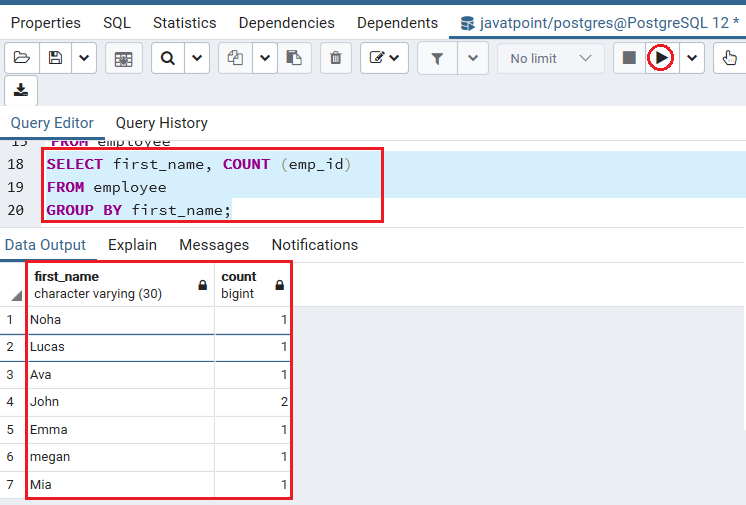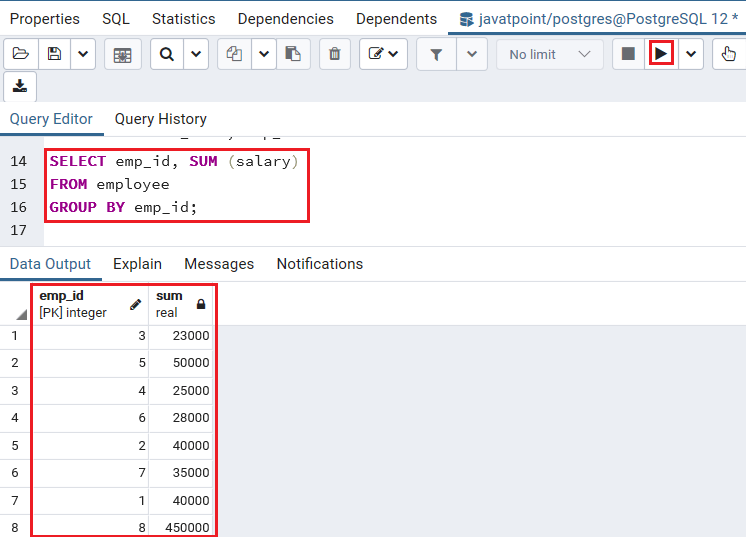
Use those practices that best benefit your needs and goals. Your particular goals and needs may vary. The majority, if not all, of the examples provided, is performed on a personal development/learning workstation-environment and should not be considered production quality or ready. They are not the utmost best solution(s).
#Postgres in clause how to
Among those, he shares a love of tabletop RPG games, reading fantasy novels, and spending time with his wife and two daughters.ĭisclaimer: The examples presented in this post are hypothetical ideas of how to achieve similar types of results. Other favorite activities find him with his nose buried in a good book, article, or the Linux command line. Josh Otwell has a passion to study and grow as a SQL Developer and blogger.
#Postgres in clause free
To receive email notifications (Never Spam) from this blog (“Digital Owl’s Prose”) for the latest blog posts as they are published, please subscribe (of your own volition) by clicking the ‘Click To Subscribe!’ button in the sidebar on the homepage! (Feel free at any time to review the Digital Owl’s Prose Privacy Policy Page for any questions you may have about: email updates, opt-in, opt-out, contact forms, etc…)īe sure and visit the “Best Of” page for a collection of my best blog posts. Have I mentioned how much I love a cup of coffee?!?! Visit the Portfolio-Projects page to see blog post/technical writing I have completed for clients. Please share your findings here, with someone else you know who would get the same value out of it as well. But there are two syntax variants of IN and two variants of ANY. I truly hope you discovered something interesting and enlightening. 370 (Strictly speaking, IN and ANY are Postgres 'constructs' or 'syntax elements', rather than 'operators'.) Logically, quoting the manual: IN is equivalent to ANY.

Thank you for taking the time to read this post. I would love to know of better practices and any other observations in the comments below.īe sure and visit the stellar on-line PostgreSQL 10 Documentation for any related questions. While this blog post is not exhaustive by any measure when it comes to subqueries as predicate filters, my hope is that it is a solid start in the right direction for you. The subquery selects and returns more than one column. LINE 3: WHERE cal_burned > ( SELECT day_walked, cal_burned FROM may_s. Here are error examples if you attempt retrieving multiple rows for this type of subquery:įitness- > WHERE cal_burned > ( SELECT day_walked, cal_burned FROM may_stats ) ĮRROR: subquery must return only one column Scalar Subqueries from the official documentation for more information.) This type of subquery is known as a scalar subquery. Successful execution for this individual subquery depends on it only returning one column and one row from that column. We can essentially take that original ‘exploratory’ query, and ‘feed’ it (so to speak) to the WHERE clause like so:įitness- > WHERE cal_burned > ( SELECT ROUND ( AVG (cal_burned ) ) FROM may_stats ) This is a prime use case for filtering with a subquery in the WHERE clause. While this does work, I’m using two separate queries to arrive here. I’ve had numerous hikes above the average! WHERE CASE WHEN x 0 THEN y/x > 1.Fitness => SELECT day_walked, cal_burned, duration The provided context is used for the preparation of the statement, not for the execution of the statement. For example, this is a possible way of avoiding a division-by-zero failure: When TOP is used with no ORDER BY clause, the query is non-deterministic and may return any rows up to the number specified by the TOP operator. The example above can be written using the simple CASE syntax:Ī CASE expression does not evaluate any subexpressions that are not needed to determine the result. This is similar to the switch statement in C.

If no match is found, the result of the ELSE clause (or a null value) is returned. The first expression is computed, then compared to each of the value expressions in the WHEN clauses until one is found that is equal to it. There is a “ simple” form of CASE expression that is a variant of the general form above:

The data types of all the result expressions must be convertible to a single output type. If the ELSE clause is omitted and no condition is true, the result is null. If no WHEN condition yields true, the value of the CASE expression is the result of the ELSE clause. If the condition's result is not true, any subsequent WHEN clauses are examined in the same manner. If the condition's result is true, the value of the CASE expression is the result that follows the condition, and the remainder of the CASE expression is not processed.

Each condition is an expression that returns a boolean result. The SQL CASE expression is a generic conditional expression, similar to if/else statements in other programming languages:ĬASE clauses can be used wherever an expression is valid.


 0 kommentar(er)
0 kommentar(er)
